One blog post. That’s all it takes to fill a week’s worth of social media posts, turn into a short YouTube video, become an infographic, and even stretch into an email series.
That’s how content repurposing works. No need to create fresh content from scratch every time. Marketers love it, 94% are using it to make the most of their content without adding extra work.
This post covers content repurposing, its benefits, and how transforming one piece into many grows reach while saving time. You’ll find steps, tools, examples, automation techniques, and a checklist for implementation.
Repurposing content isn’t just smart, it’s practical.
What Is Content Repurposing?
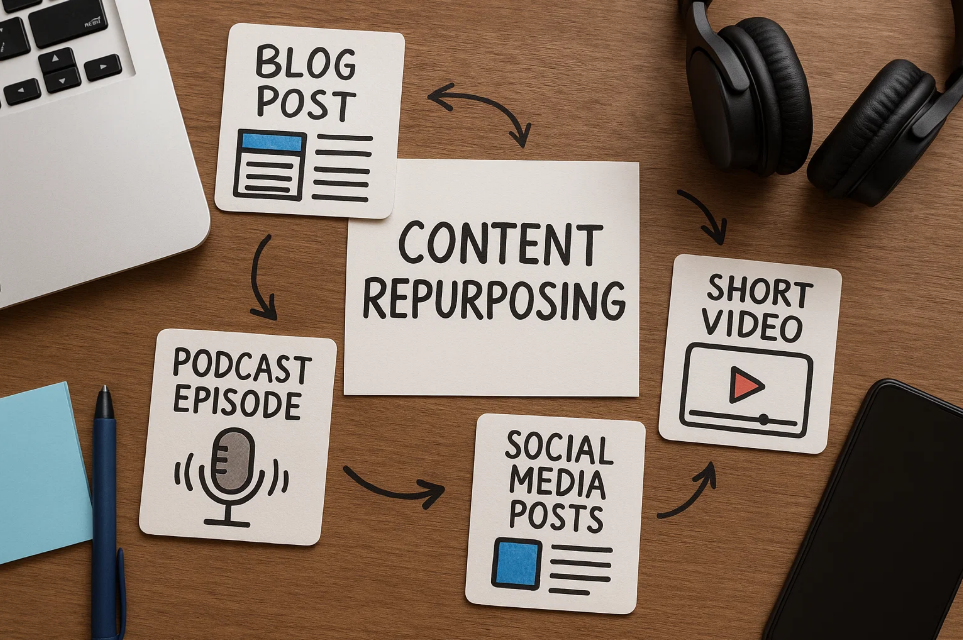
Core Definition
Content repurposing means turning existing content into different formats without changing its message. It could be a blog post turned into a short video, or podcast episodes turned into social media posts. The goal is to get more reach without starting from zero.
This makes repurposing content a smart move for brands that want to save time and speak to new audiences across different platforms.
Key Variations & Synonyms
People may call it by other names, such as:
- Content recycling
- Content adaptation
- Content transformation
They all mean using old content in new ways to stretch its value.
How Content Repurposing Works
Here’s a simple way to think about the process:
- Audit existing content.
- Select what’s worth repurposing.
- Adapt it into a new format.
- Distribute across social media platforms, blogs, email, or other channels.
- Monitor performance to see what works and what needs a tweak.
Content Repurposing vs. Content Creation
Creating content from scratch takes more time, more energy, and often more money. Repurposing content cuts it down by reusing what already exists.
Fresh content is needed sometimes, but not every week. Repurposing extends the life of blog content, podcast episodes, and videos. It also makes it easier to stay active across social media channels.
Repurposing content should be easy!
Use RecurPost to schedule and share your repurposed posts across multiple platforms, maximizing reach with minimal effort. Learn more to make the most out of your recycled content.
👉 Click here to try it free for 14 days.
Top Benefits of Repurposing Content
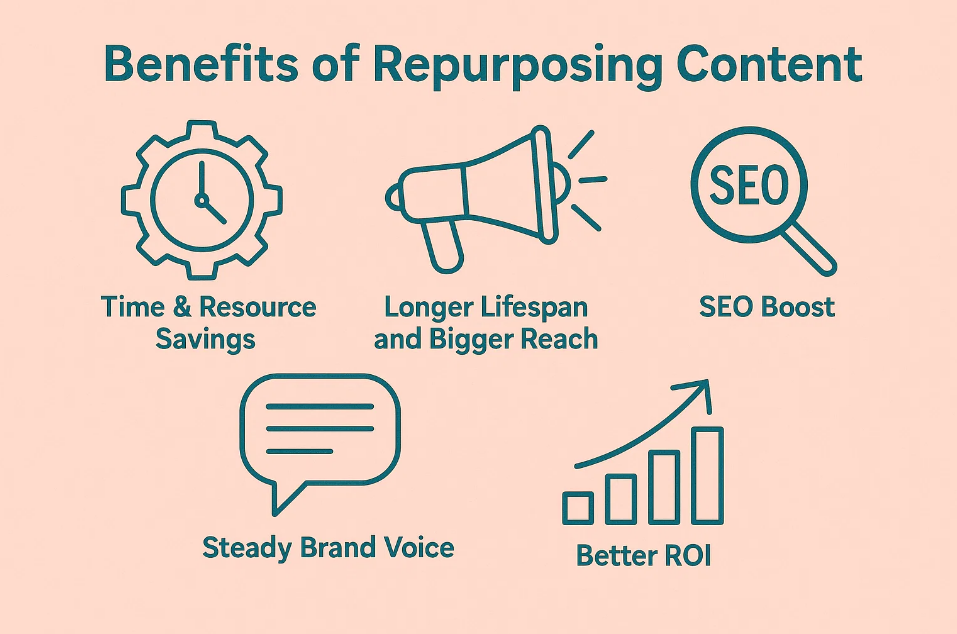
Time & Resource Savings
Repurposing content can cut down content creation time by up to 70%. Instead of writing a new blog post every week, one long-form piece can fuel multiple content pieces like social posts, infographics, or a YouTube video.
Start with: A content audit. Pick past blog content that performed well and is still relevant. Evergreen content works best.
Longer Lifespan and Bigger Reach
Old blog posts can live again as fresh content on different platforms. That same blog could be turned into a podcast, a quote graphic, or a quick video. This way, existing content keeps showing up in front of new audiences.
Quick fix: Update outdated numbers or links. Swap visuals. Add something new to keep it current.
SEO Boost
Repurposing content increases search engine visibility. One idea targets different keywords across multiple formats, such as blog posts and YouTube videos, while creating more opportunities for backlinks.
Tip: Add strong metadata and clear headings in each version to make them easier to find.
Steady Brand Voice
When one message shows up in different formats, it sticks. Repurposing content across social media platforms, videos, and blogs helps reinforce the same message with the same tone.
Quick tip: Stick to a simple style guide to keep brand voice, colors, and design consistent.
Better ROI
Content repurposing can lead to five times more content and up to 80% better use of time and budget. Instead of spending hours creating fresh content, reuse old blog posts or podcast episodes to create something new.
Track this: Measure time saved, traffic gained, or new leads per asset. It’s a clear way to show the value of repurposing content.
Step-by-Step Guide to Repurposing Content for Maximum Engagement

Common Content Repurposing Problems and How to Solve Them
Content repurposing saves time and increases reach, but marketers encounter challenges during implementation. Solving these obstacles creates smoother workflows and improves results.
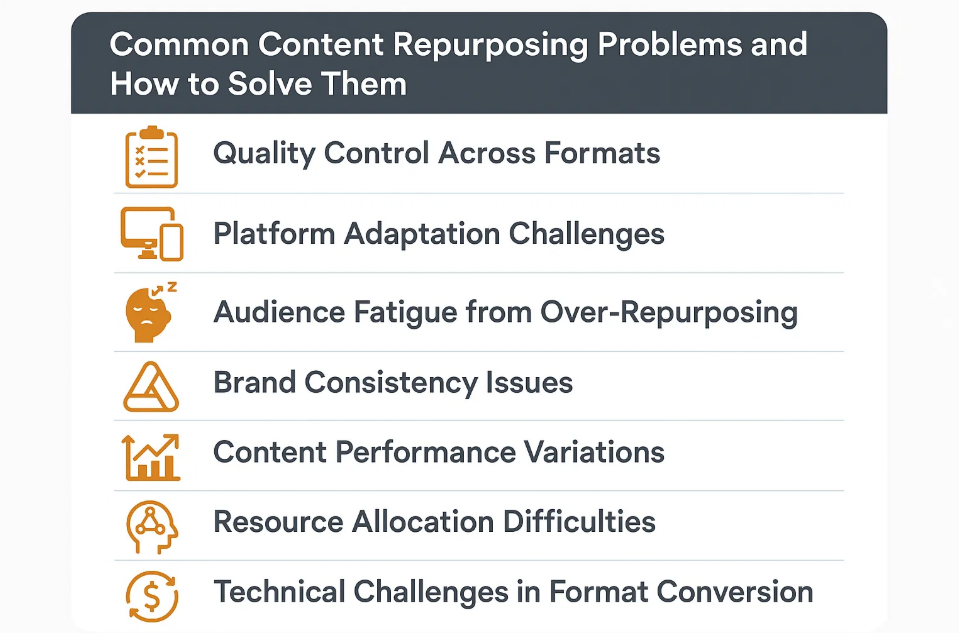
Quality Control Across Formats
One blog post can turn into five different pieces, but keeping quality consistent across all formats takes work. Video scripts often sound natural when spoken, but feel awkward as blog posts. Similarly, infographics require precise data visualization that text-heavy content might lack.
Quick fix: Create format-specific guidelines. Write down tone, length, and style rules for each platform. Review each piece before publishing to catch format mismatches. For complex transformations, assign a dedicated editor to maintain quality standards.
Platform Adaptation Challenges
What works on LinkedIn won’t work on TikTok. The same content needs different hooks, lengths, and visual styles for each platform. Many marketers struggle with adapting content properly, resulting in poor engagement on certain platforms.
Solution: Build platform templates. Create standard formats for captions, video lengths, and image sizes. This makes adaptation faster and more consistent. Study platform-specific analytics to understand what format modifications drive the most engagement on each channel.
Audience Fatigue from Over-Repurposing
Audiences tune out when seeing the same message repeatedly across platforms. People follow brands on multiple channels and notice repetitive content. This fatigue leads to decreased engagement rates and potential unfollows.
Smart approach: Space out repurposed content by at least two weeks between platforms. Change the angle or focus for each version to keep things fresh. Track engagement metrics across platforms to identify signs of content fatigue and adjust your repurposing schedule accordingly.
Brand Consistency Issues
Brand voice can get diluted when repurposing content across formats. Different team members might adapt content in ways that don’t match the brand tone. This inconsistency weakens brand recognition and confuses the audience about your core message.
Fix: Create a simple brand voice guide with examples. Include do’s and don’ts for tone, word choice, and messaging. Share this with anyone who handles content adaptation. Implement a review process where one person checks all repurposed content for brand alignment before publishing.
Content Performance Variations
The same message might perform well as a blog post but flop as a video. Not every format works for every piece of content. Many marketers waste resources by forcing content into formats that don’t suit the original message.
Track this: Monitor performance for each format. If something consistently underperforms in a specific format, skip that combination next time. Focus on what actually works. Create a performance matrix that maps content types to their best-performing formats to guide future repurposing decisions.
Resource Allocation Difficulties
Repurposing content requires time and effort. Teams underestimating adaptation work rush the process, producing poor quality results and causing creator burnout.
Plan better: Block out specific time for repurposing work. Batch similar tasks together, like creating all social media versions at once. This makes the process more efficient. Calculate the actual time spent on repurposing versus creating new content to demonstrate the real efficiency gains to stakeholders.
Technical Challenges in Format Conversion
Converting content between formats often requires specialized skills or tools. Many teams lack expertise in creating well-designed infographics or professional videos from blog posts.
Practical solution: Invest in basic training for common conversion tools or outsource specialized format conversions. Create a resource library of templates, stock images, and audio files that simplify the technical aspects of repurposing. Tools like Canva, Adobe Express, or Descript can make format conversions more accessible to team members without specialized skills.
Measuring True ROI
While repurposing saves creation time, measuring its actual impact on marketing goals can be challenging. Teams struggle to attribute results to repurposed content versus original content.
Measurement approach: Set up tracking parameters for each repurposed piece to monitor its individual performance. Compare the combined results of repurposed content against the original to calculate the true ROI. Track time saved in creation versus time spent on adaptation to determine efficiency gains.
Content Repurposing Techniques and Formats
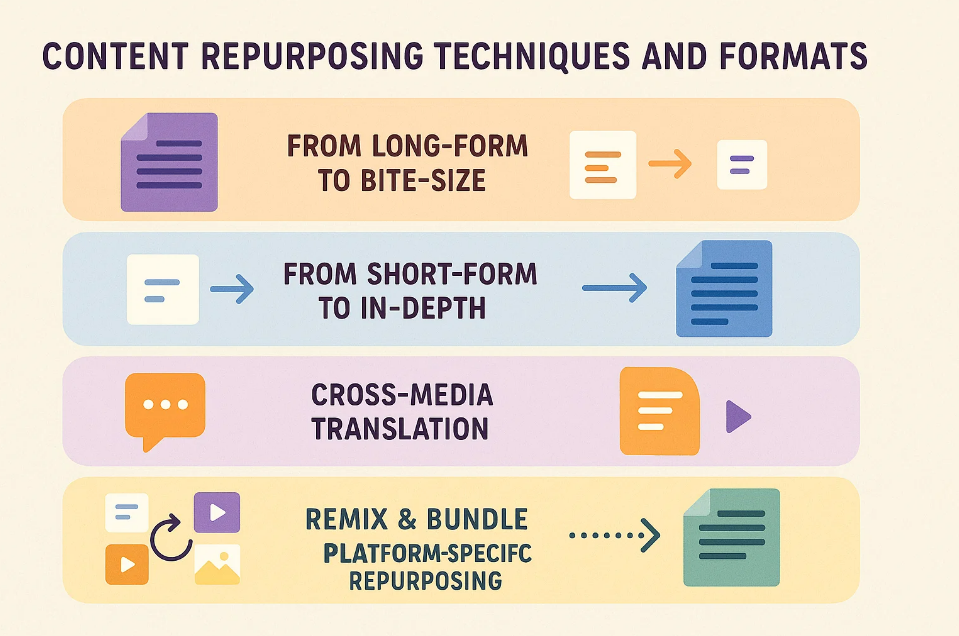
From Long-Form to Bite-Size
Long-form content, like a blog post or video content, doesn’t have to stay long. One detailed article can be turned into:
- A short YouTube video or a quick webinar
- An infographic with key points and stats
Break it down. A one-page outline can help map each section to its new format. These bite-sized pieces keep the core idea but fit fast-scrolling feeds.
From Short-Form to In-Depth
Small posts can grow into full articles. A tweet or Instagram caption that gets good engagement? That’s a start.
- Social media posts can become full blog posts
- FAQs or comment sections can be shaped into guides
Social listening tools help find what questions people ask. Use that to build content people are already looking for.
Cross-Media Translation
One format can be switched to another without losing its message.
- A video can turn into an article by using the transcript
- A podcast episode can become a blog post or a quote graphic
Use transcription tools to save time. Edit lightly for flow and clarity.
Remix & Bundle
Old blog posts don’t have to stay single. They can be grouped into:
- A round-up post with links to related content
- An e-book made from multiple posts around one topic
Add a quiz or checklist inside for better engagement and longer page visits.
Platform-Specific Repurposing
Platforms require specific content styles. Repurpose content across platforms by:
- TikTok and Reels: fast, punchy clips with strong hooks
- LinkedIn: thoughtful posts, data insights, or SlideShares
- Pinterest: tall infographics and carousel pins
It’s the same message, just dressed differently for each place. Use platform best practices for tone, length, and visuals.
Want to repurpose content faster?
Check out how Artificial Intelligence for Social Media can help you turn blogs into social posts, videos, and more, saving time and keeping your content consistent.
Content Repurposing Framework: A Simple System
A strong content repurposing process needs more than random tweaks. It works best when it follows a clear loop. Here’s how to build a repeatable system that brings long-term value.
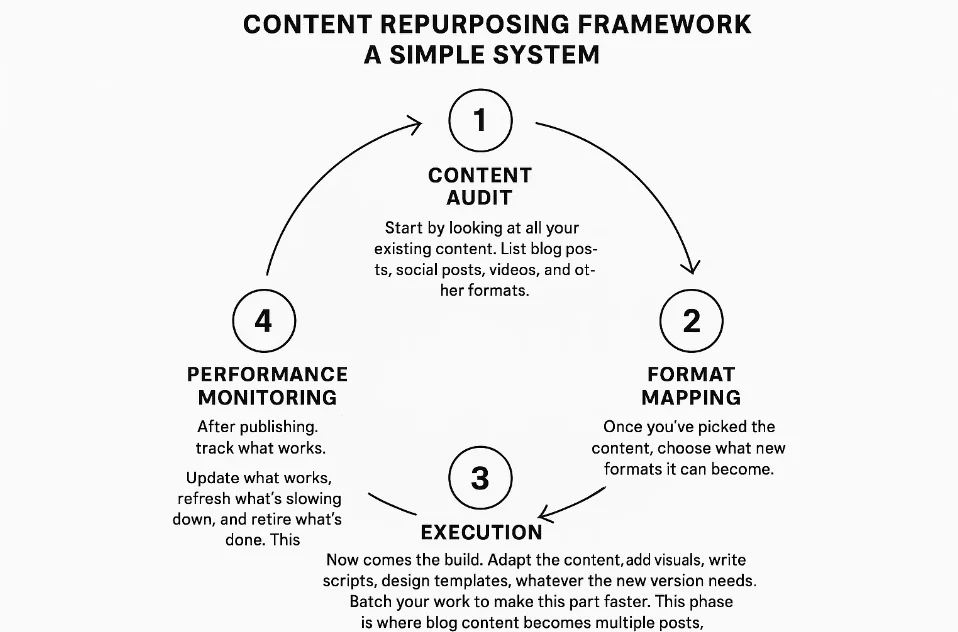
Phase 1: Content Audit
Start by looking at all your existing content: list blog posts, social posts, videos, and other formats.
Look for:
- High-performing posts
- Evergreen content that still feels fresh
- Topics that match current goals
Phase 2: Format Mapping
Once you’ve picked the content, choose what new formats it can become.
Examples:
- A blog post can turn into a YouTube video
- A research report can become an infographic
- A podcast episode can turn into a blog post
Keep the message the same, just shift the format to match the platform.
Phase 3: Execution
Now comes the build. Adapt the content, add visuals, write scripts, design templates, whatever the new version needs. Batch your work to make this part faster.
This phase is where blog content becomes multiple posts, videos, or even a SlideShare presentation.
Phase 4: Performance Monitoring
After publishing, track what works.
Look at metrics like:
- Engagement rate
- Traffic per format
- Time saved on content creation
Update what works, refresh what’s slowing down, and retire what’s done. This keeps your content engine running without wasting time.
Looking for more ideas? Check out these social media marketing post ideas to inspire your next batch of repurposed posts.
Advanced Tips for Smarter Repurposing
Repurposing Old Blog Posts Effectively
Not all old blog posts are worth repurposing. Choose ones that still get steady traffic or had strong engagement when they were new. Look for:
- Posts with high page views or time on page
- Evergreen content that still answers current questions
- Topics that align with present marketing goals
Wait at least 6 to 12 months before refreshing and republishing. That gives time to gather performance data and see what still has value.
Update headlines, tweak intros, and add fresh stats to give the post a new life. This saves manual effort while keeping the content relevant.
If you’re building a long-term content schedule, explore RecurPost’s social media content planner to keep your plan organized.
Timing Considerations
When repurposing content, timing matters. Spacing things out avoids repetition and keeps the audience interested.
Good timing tricks:
- Match evergreen topics with steady gaps between formats
- Use seasonal events or yearly trends for themed republishing
- Spread different formats over a few weeks to hit different audiences
A social media post can come a week after the blog goes live. An infographic can drop a month later. Same message, just spread out for more visibility.
For instance, if your blog post ties into a holiday, consider using this April social media holidays guide to align your repurposing schedule.
Real-World Examples & Mini Case Studies
B2C Example: Shopify Masters
Shopify Masters turned one podcast episode into:
- A YouTube video
- A blog post
- Multiple social media posts
This one move doubled their reach and gave their SEO a healthy push. Each format spoke to a different part of their audience: listeners, readers, and scrollers.
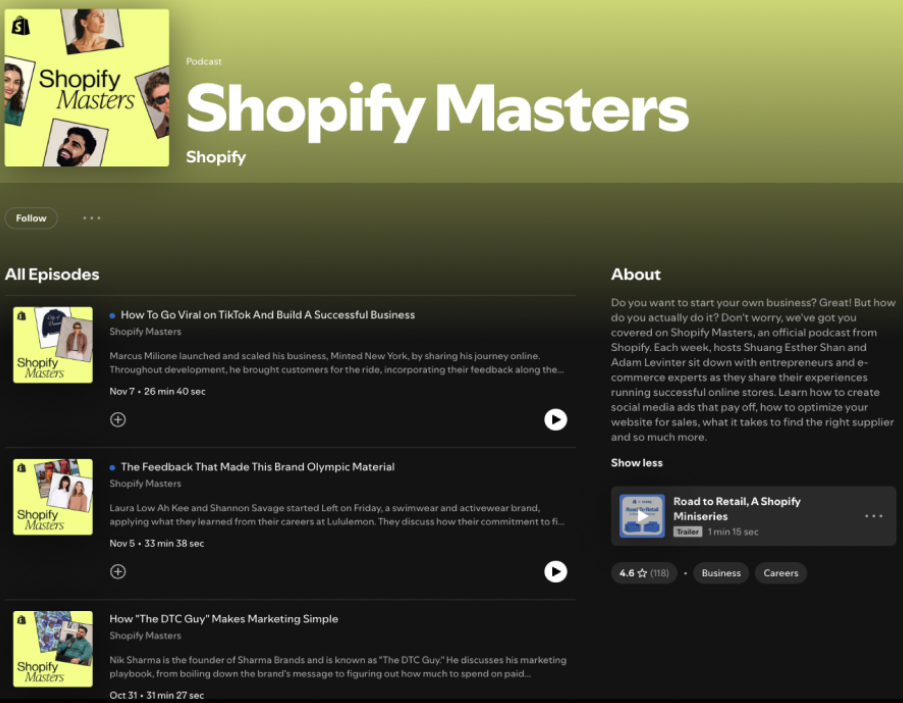
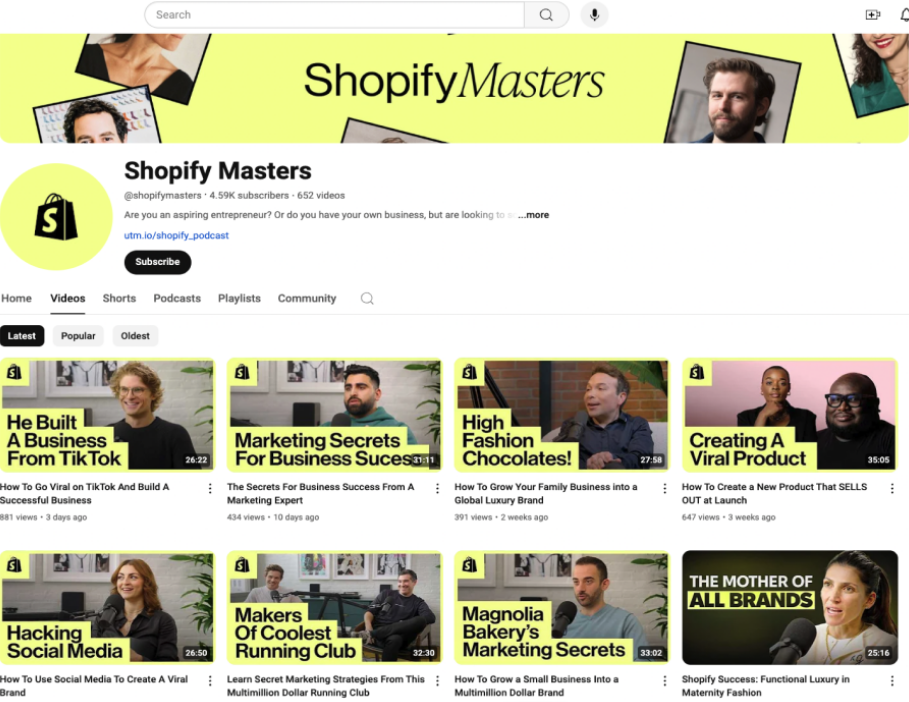

B2B Example: TechStartups via TranscribeTube
TechStartups used TranscribeTube to turn video interviews into written content. From one interview, they created:
- A full transcript
- A polished blog post
- Quote graphics for LinkedIn and Twitter
The result? 30% more traffic and 40% less production time. Repurposing content helped them scale without hiring more help.
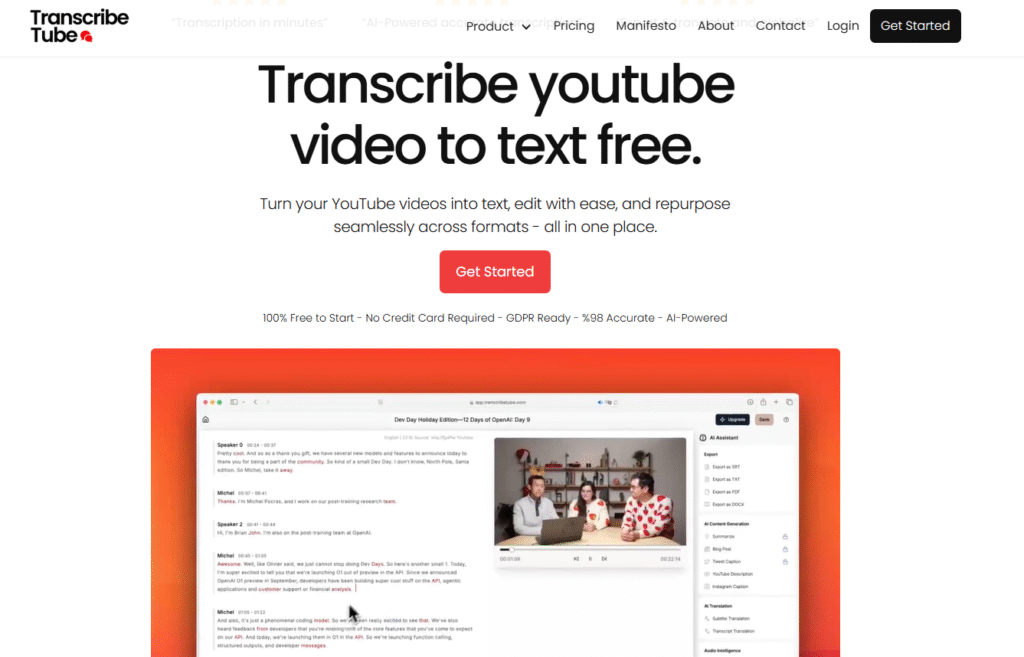
Real Estate Agent Case
One real estate agent took a fresh approach. Listing descriptions became:
- Local neighborhood guides
- Short video tours
- Infographics showing key property features
That small shift brought in 50% more inquiries and way more social media engagement. Repurposing content made every listing go further.
How RecurPost Simplifies Content Repurposing
Evergreen Content Libraries
RecurPost helps keep high-quality content alive. With evergreen content libraries, posts don’t just go out once; they keep cycling automatically. This keeps feeds fresh without creating new content every day.
Add your best blog posts, video content, or social media posts, and let the tool handle the rest. It’s one of the easiest ways to reuse old content across social media channels.
Bulk Scheduling & Multi-Platform Support
Planning ahead saves time. RecurPost lets you schedule dozens of pieces at once, across 10+ platforms. You can queue content variations for each social media platform from one dashboard.
This means one blog post can turn into multiple posts ready to go out on LinkedIn, Facebook, Instagram, Twitter, and Pinterest, all without switching tabs.
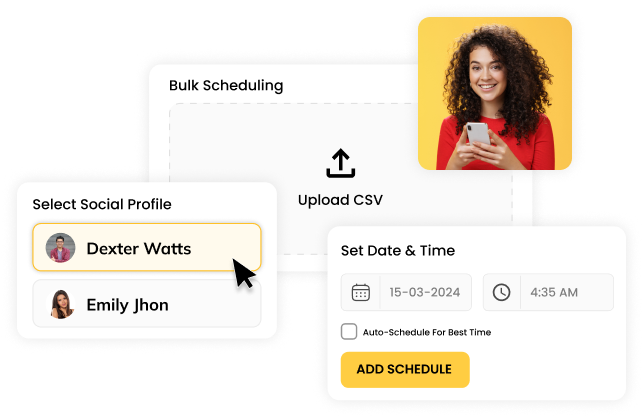
Automation Integration Considerations for Content Repurposing
RecurPost connects easily with other tools. You can:
- Pull content automatically using RSS feeds
- Set up workflows with Zapier
- Access APIs for custom integrations
This makes it simpler to fit content repurposing into your existing strategy without extra manual effort.
Tool Selection Considerations
When choosing a content repurposing tool, look for:
- Content variation features
- Analytics that show what’s working
- A simple interface that teams can use without training
RecurPost checks all the boxes and helps teams repurpose content without tech stress.
Need a starting point? Try using this sample social media calendar to structure your content rollout.
Key Metrics for Measuring Automated Repurposing
Success isn’t just about publishing more; it’s about better results. RecurPost tracks:
- Engagement rate per post
- How often does content get reposted
- Reach growth over time
- Time saved compared to manual posting
These metrics show how well content repurposing is working across various platforms.
How Long Before You Can Repurpose Content?
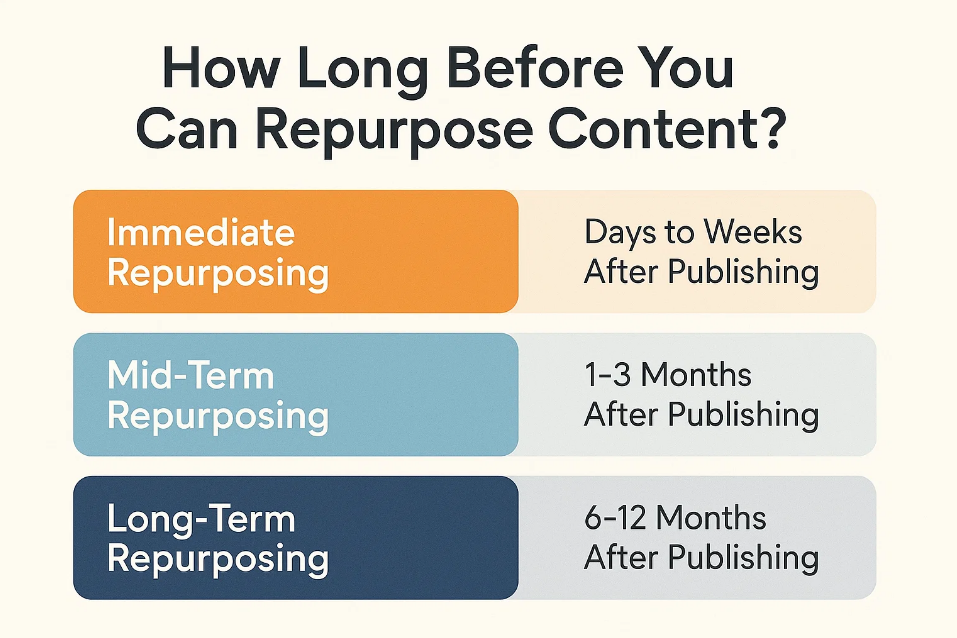
You can repurpose content almost immediately after it has been published, but the timing depends on your goals and strategy. Here are some scenarios to guide you:
Immediate Repurposing (Days to Weeks After Publishing)
- Cross-Platform Sharing: Repurpose a blog post into social media snippets, infographics, or a quick video.
- Audience Segmentation: Adapt content to target different audience groups.
- Trending Topics: If the content aligns with current trends, repurpose it right away to maximize visibility.
For instance, if your blog post ties into a holiday, consider using this April social media holidays guide to align your repurposing schedule.
Mid-Term Repurposing (1-3 Months After Publishing)
- Performance Analysis: Use analytics to identify top-performing content. Repurpose it into different formats like podcasts, webinars, or case studies.
- Seasonal Updates: Modify content to align with upcoming seasons, events, or campaigns.
Long-Term Repurposing (6-12 Months After Publishing)
- Evergreen Content: Update and repurpose evergreen posts to keep them relevant.
- Content Refresh: Add new data, visuals, or insights to older posts for re-publishing.
- Compilations: Combine multiple related pieces into an eBook, guide, or white paper.
The key is to analyze the content’s relevance and performance before repurposing. High-performing, evergreen, or trending content is best suited for quick repurposing, while older content can be updated and reused strategically.
Don’t let great content go to waste!
RecurPost helps you recycle your top-performing posts and schedule them across all your channels automatically.
👉 Click here to try it free for 14 days.
Measuring Content Repurposing Success
Publishing content is one thing. Knowing if it works is another. Tracking the right numbers helps improve what’s already out there and plan better next time.
Here’s how to measure repurposing content the smart way:
Engagement Metrics
Start with the basics. Are people interacting with your repurposed content?
Track:
- Likes
- Shares
- Comments
Compare these across formats like blog posts, social media posts, or videos to see what pulls the most attention.
SEO Metrics
Repurposing content can improve search performance if done right. Look at:
- Increase in organic traffic
- Keyword rankings across different formats
If a blog post or YouTube video starts pulling in search traffic, it’s working.
Efficiency Metrics
Content repurposing saves time and budget. But how much?
Measure:
- Time saved per post
- Cost difference compared to creating fresh content
Use these numbers to prove value when planning your content marketing strategy.
Audience Metrics
Each new format can reach a different target audience.
Track:
- New followers or subscribers
- Where did they come from
- What content brought them in
This shows which content formats connect best with different audiences.
Tip: Set monthly benchmarks. Review and compare to see what needs more work or what’s worth repurposing again.
Quick-Start Checklist for Your Repurposing Plan
Want to get started fast? Follow this checklist to build a content repurposing flow that works on repeat.
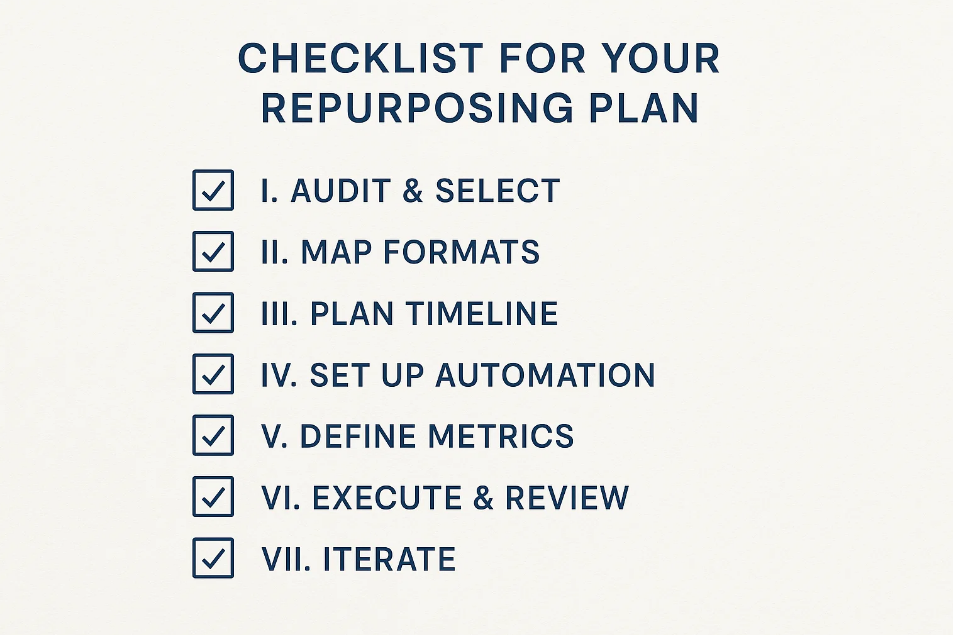
I. Audit & Select
Look through existing content. Pick five evergreen assets with strong past performance. Think blog posts, videos, or podcast episodes that still feel fresh.
II. Map Formats
Choose two or three new formats for each asset. A blog post can become:
- A social media post
- A short video
- An infographic
This spreads the same message across various channels.
III. Plan Timeline
Decide when and how often to share the repurposed content. Stagger formats to avoid flooding your feed and keep things fresh for the audience.
IV. Set Up Automation
Use RecurPost to load all assets into content libraries. Set schedules for each platform to keep content flowing without manual effort.
V. Define Metrics
Set clear goals for each content type. Track things like:
- Engagement
- Traffic
- Time saved
These numbers show what’s working and what to scale.
VI. Execute & Review
Launch the repurposed content. Let it run for a few weeks, then review performance based on your set metrics.
VII. Iterate
Keep the good. Refresh what slows down. Retire what’s no longer useful. This loop keeps your content working harder, not longer.
Save time and keep your audience engaged!
RecurPost allows you to repurpose your best content, ensuring your message reaches more people on every platform.
👉 Click here to try it free for 14 days.
Conclusion
Content repurposing isn’t about doing more. It’s about doing smarter. By turning one solid piece into multiple content formats, there’s less need for creating fresh content all the time. This keeps your content marketing efforts consistent, without extra stress on time or budget.
From auditing existing content to automating with tools like RecurPost, this guide laid out each step. Along the way, it covered real examples, helpful tips, and clear metrics to measure success.
Begin with one blog post. Divide it into smaller components. Distribute across platforms. Let repurposed content multiply your reach.
Work once. Publish often. Let repurposing keep your message moving.
Step-by-Step Guide to Repurposing Content for Maximum Engagement

FAQs About Content Repurposing
1. Can content repurposing hurt SEO if the same content appears in multiple places?
No, if repurposed content is rewritten or restructured into a new format, it won’t be flagged as duplicate. Just avoid copy-pasting full sections without changes.
2. How often should I repurpose the same content?
There’s no fixed rule, but refreshing and reusing content every 6 to 12 months works well. Spread out repurposed versions to avoid audience fatigue.
3. Should I repurpose content that didn’t perform well originally?
Only if the topic is still valuable. Try changing the angle or format. A blog post that flopped might do better as a video or carousel.
4. What’s the best way to track the ROI of repurposing content?
Compare time and cost saved, plus results like new leads, traffic, or engagement, versus starting from scratch.
5. Do I need to edit visuals and headlines when repurposing?
Yes. Each format and platform has its own best practices. A title that works for a blog might not fit an Instagram post.
6. Can I repurpose curated content or third-party sources?
Not directly. But you can add your take or context to the topic, link back to the original, and create new content around it.
7. How much content do I need before I start repurposing?
Even five to ten pieces are enough to begin. A few good evergreen posts can fuel weeks of social media and more.
8. Should I repurpose for every social media platform?
Not all. Focus on the platforms where your audience is active. Repurpose smart, not everywhere.

Saurabh Chaturvedi is a content writer at RecurPost. Specializing in social media management and marketing, Saurabh is dedicated to crafting engaging and informative articles. His passion for clear, exciting content keeps readers eager for more.





